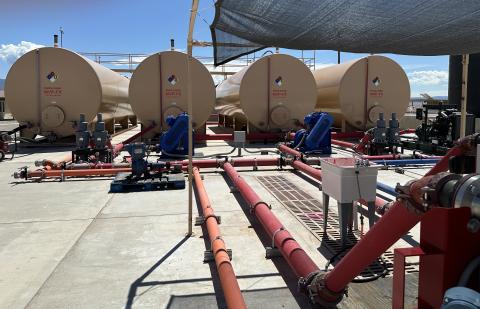NEW MEXICO—Kirtland Air Force Base, with over 100 mission partners, forms a vital defense hub in Albuquerque. From disaster relief to fighting insurgencies, continued collaboration ensures success that impacts New Mexico and beyond. This includes hosting the USDA Forest Service’s Albuquerque Air Tanker Base, a partnership that dates to 1977.
Earlier this year, the air tanker base completed a game-changing upgrade. With a brand-new ramp designed to accommodate very large air tankers , this facility is poised to increase the efficiency and pace at which the agency responds to wildfires.
“It’s like trading your tried-and-true running shoes in for a brand-new pair that promises peak performance,” says Matt Rau, Cibola National Forest and National Grasslands fire staff officer. Rau compares the world of aerial wildland firefighting to the agility and finesse of an elite athlete, where speed and precision are everything. That desired speed and precision inspired the re-evaluation of the Albuquerque air tanker base’s capabilities after the aerial firefighting organization, 10 Tanker, moved its headquarters to New Mexico 10 years ago.
Project Alpha-Ramp was completed April 22. With the alpha ramp upgrade now complete, full-time access is now available for DC-10s, C-130s, RJ85s, BAE146s, and 737s. “When we talk about the air tanker base’s target operational ability—the completion of the ramp project is it,” says Rau.

Very large air tankers are the largest air tankers currently used by the Forest Service to carry fire retardant, with a 9,400-gallon capacity compared to the 3,000-4,000-gallon capacity of large air tankers. However, to provide very large air tankers access to the Albuquerque air tanker base, a new ramp, graded to handle the heavier payload of these larger aircraft, was needed. That need has been realized and achieved after two years of renovation work.
An earlier phase of the air tanker base revamp, which will aid with quicker response times, includes increased pumping capabilities, new piping and plumbing in the retardant plant—all of which fall under the more than $15 million in funding New Mexico Senator Martin Heinrich helped secure. Before this upgrade, it would take approximately 90 minutes to fill an aircraft with fire retardant only. That number has decreased to approximately 45 minutes for both a fuel and retardant fill and as little as 10-15 minutes if only a retardant fill is needed. The air tanker base is now one of only two bases in the country that can fill two very large air tankers simultaneously.
The increased efficiency of the air tanker base is further amplified by four new fire retardant tanks that hold 25,000 gallons of retardant each. One tank is dedicated to mixing, two to holding and one to loading, meaning 75,000 gallons of mixed fire-retardant are always available on the air tanker base.
With expanded capabilities, this air tanker base will undoubtedly prove to be a regional and national asset. The air tanker base can respond to fires in the Southwestern Region, as well as the Rocky Mountain, Intermountain and Southern regions. The Forest Service staffs the air tanker base with full-time and seasonal employees. There can be up to 30 individuals working at the air tanker base during fire response operations, including contractors and pilots.
With these valuable upgrades, the Albuquerque air tanker base is ready to usher in a new era of speed, efficiency and precision in wildland firefighting efforts. The sky’s the limit as this base takes off toward a future where every second counts.






